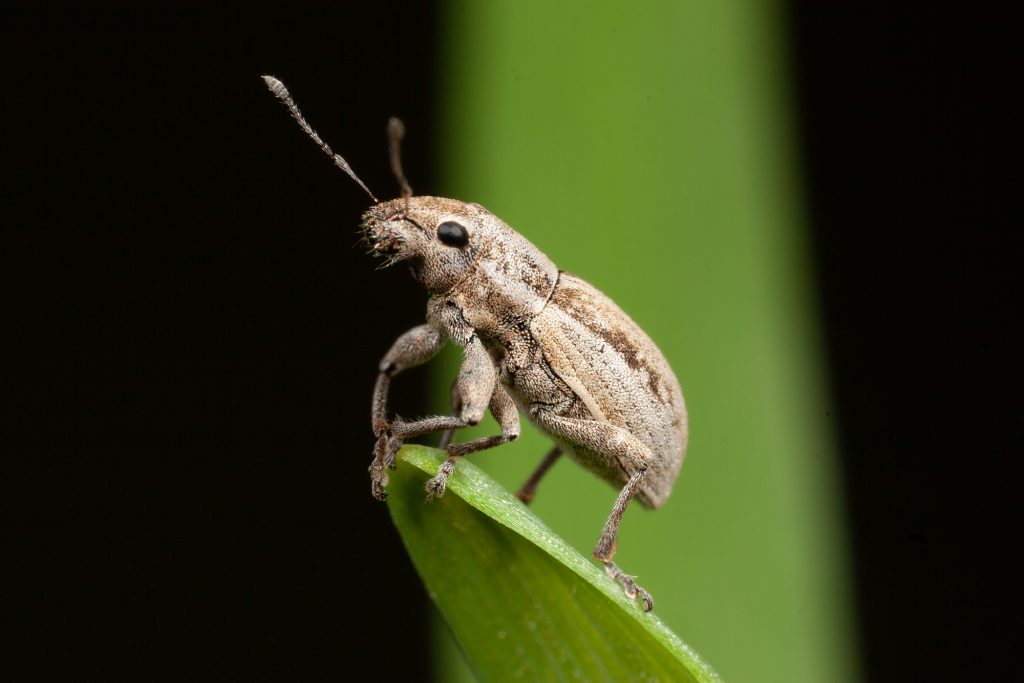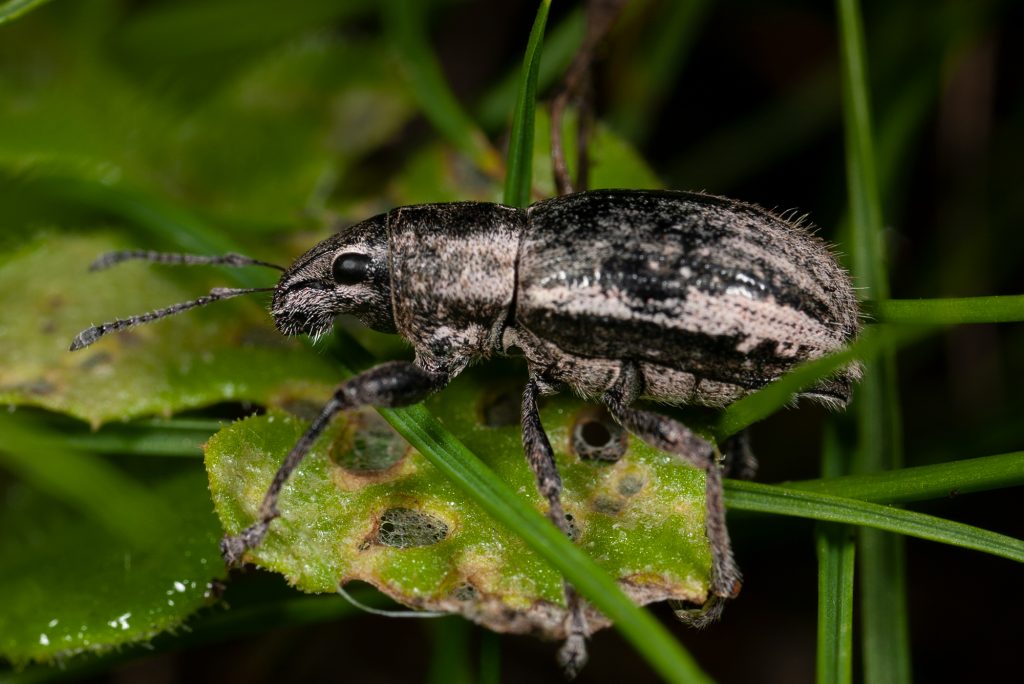It’s common for weevils to cause extensive damage to crops and pastures in autumn and winter. Distinguishing the specific culprit is the first management challenge.
Where have they been reported?
Heavy infestations of adult weevils (6 weevils per 100 mm of row), probably the small lucerne weevil (Atrichonotus taeniatulus), have been causing widespread problems in the Cowra, Cudal, Canowindra area of the NSW Central Tablelands. The weevils have been decimating a lucerne crop and taken out a 20 ha arrowleaf clover stand.
In the same region, these weevils have also recently destroyed 60% of a canola crop on heavy red loam soils. The area has experienced continuing (if not growing) weevil problems over the last six years across a variety of paddocks.
Incorporation of chlorpyrifos prior to sowing and fipronil seed treatment is reported to have provided effective control in canola.

Further north in the Dunnedoo area of the Central Tablelands, large populations of larvae (only) of the small lucerne weevil have been causing severe damage to a lucerne stand by burrowing through the plant crown.
In the same area, whitefringed weevil (Naupactus leucoloma) and Flores weevil (Floresianus sordidus) (adults and larvae) have been damaging the root systems of tonic plantain (forage).

Further south near Wagga in the South West Slopes district, adult weevils, probably the grey-banded leaf weevil (Ethemaia sellata), are causing substantial damage to canola seedlings. The symptoms of weevil feeding are large scallops from canola leaves to complete seedling loss.
The encroaching wave of weevil activity seems to be emerging from light loamy soils.
Similar scalloping damage, very typical of weevils, has been spotted in a number of canola and newly sown pasture paddocks.
In a canola crop near Colbinabin in Victoria’s Northern Country, seedling damage resembling that caused by weevils is widespread across the paddock, although only the odd plant is as yet failing. Most damage is from ring-barking or cutting through the young stems. Adult weevils have also been located in other canola crops in the area, although the damage to this point has been minimal.
Weevil identification
Weevil adults and larvae can cause damage to all grain crops, although adults are more frequently associated with above ground damage. Successful management of pests starts with the correct identification, although weevils are particularly challenging to identify.
There are numerous species of weevil found in cropping paddocks; the Mandalotus group alone may account for more than ten pest species.
The distinguishing feature of all adult weevils is the extended snout or rostrum on the head. Generally, it is much easier to identify an adult weevil than a larva.
Distinguishing weevil larvae from other creamy-coloured insect larvae found in the soil (e.g. cockchafers and wireworms) is relatively straightforward – weevil larvae have no legs.
We have prepared the following analysis as a guide to help identify nine weevil groups through their hosts or appearance. Please note, this is based on generalisations that do not always hold true.
Weevil species by crops attacked
It is possible to narrow down the range of pest weevils according to the crops in which they are found.
In canola and related brassica crops, common weevil pests include vegetable, Mandalotus, small lucerne, Fuller’s rose, grey-banded leaf, and spotted vegetable weevils. Both adults and larvae of these species are capable of causing damage to canola, although it’s predominantly adults for Mandalotus and spotted vegetable weevils.


In legumes, which include lucerne, clovers and medics and often pulses, the common weevil pests include whitefringed, Sitona, small lucerne, Fuller’s rose, grey-banded leaf and Mandalotus weevils. Of these, most damage is caused by the adult stages of whitefringed, Sitona and Mandalotus weevils.
In cereals, the most common weevil pests include Mandalotus, spotted vegetable, spinetailed and Polyphrades weevils. For spotted vegetable and spinetailed weevil most damage is caused by the larvae.
Distinguishing features of weevil groups
The below table identifies some the main morphological characteristics that can be used to distinguish weevil adults and larvae.
| Weevil species | Adult length (mm) | Distinctive feature of adult weevils | Larval head capsule colour |
| Fuller’s rose weevil | 8 | Yellow/grey stripe on thorax and also abdomen | Light |
| Greybanded leaf weevil | 8 | Pale band on rear of abdomen | Dark |
| Mandalotus weevil | 3 – 5 | Dull brown, paddle-shaped bristles; short snout | Yellow-brown |
| Sitona weevil | 3 – 5 | 3 white stripes on thorax; broad snout | Brown |
| Small lucerne weevil | 10 | Less distinct lateral stripes than the whitefringed weevil | Light |
| Spinetailed weevil | 7 | Winger covers taper to spines (females); long snout | Yellow |
| Spotted vegetable weevil | 7 | Mottled/speckled; longer snout | Brown |
| Whitefringed weevil | 10 – 15 | Light lateral stripes | Light |
| Vegetable weevil | 8 | Light coloured ‘V’ at rear of abdomen | Brown |

Our advice
Weevil damage can occur at any time of the season, but feeding during autumn and early winter is typically the most critical.
Inspect paddocks and nearby weeds prior to sowing and monitor crops for signs of seedling damage and bare patches within paddocks. Look for signs of chewing damage on plants, often characterised by scallop-shaped holes along the leaf margins, ring-barking of seedlings, as well as a loss of plant vigour. Searches may need to be undertaken during the night, as this is when weevils are most active.
Weevils, particularly larvae, can be difficult to control with chemicals due to their subterranean habits where they remain protected from insecticide exposure.
Exceptions are the vegetable and grey-banded leaf weevils where larvae also feed on foliage.
There are a limited number of registered products for the active stages of several weevil species.
Previous reports suggest that canola paddocks sown with fipronil-treated seed experience less feeding damage from weevils.
Acknowledgements
Sources of field reports of weevils
Warwick Nightingale – Agronomist, Delta Ag (NSW Riverina)
Mitch Small – Agronomist, Elders (NSW Central Tablelands)
Phil Stoddart – Consultant, Stoddart Agriculture (NSW Central Tablelands)
Greg Toomey – Agronomist, Landmark, (Victorian Northern Country)
Cover image: Photo by Andrew Weeks, Cesar Australia





